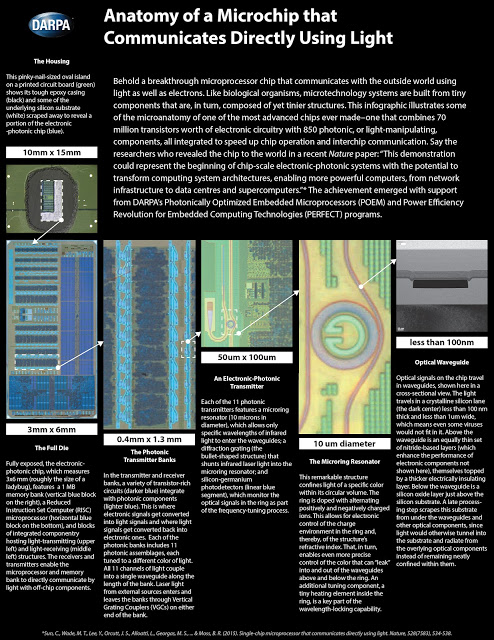Recently, DARPA-funded scientists designed and crafted a breakthrough microprocessor that combines many of the best traits of electrons and photons on a single chip. The result is a remarkable and elegant hybrid microtechnology that boggles the mind for the intricate complexity of its sub-Lilliputian architecture. To appreciate the engineering acumen involved in the development of this chip and its tens of millions of resident electronic and photonic components, DARPA has produced an annotated, graphical tour of the new chip’s innards.
Two DARPA programs are pushing to develop the electronic-photonic integrated chip.
Photonically Optimized Embedded Microprocessors (POEM)
The POEM program aims to address electrical communications link limitations by developing chip-scale, integrated photonic technology to enable seamless intrachip and offchip photonic communications that provide the required bandwidth with low energy/bit. The POEM program will exploit wavelength division multiplexing (WDM), allowing much higher bandwidth capacity per link, which is imperative to meeting the communication needs of future microprocessors. Such a capability would propel the microprocessor onto a new performance trajectory and impact the actual runtime performance of DoD-relevant computing tasks for power-starved embedded applications and supercomputing. The challenges in realizing POEM technology are developing CMOS and DRAM-compatible photonic links that are spectrally broad, operate at high bit-rates with very low power dissipation, and are tightly integrated with electronic drivers. Ultimately, the goal of POEM is to demonstrate photonic technologies that can be integrated within embedded microprocessors and enable seamless, energy-efficient, high-capacity communications within and between the microprocessor and DRAM. It is envisioned that POEM technology will be especially useful to military platforms where extreme performance coupled with low size, weight, and power is a necessity (e.g. UAVs, and satellites).
Power Efficiency Revolution for Embedded Computing Technologies (PERFECT) The power efficiency revolution for embedded computing technologies (PERFECT) program seeks to improve computational capability by improving power efficiency for embedded computer systems and providing more computing per watt of electrical power.

Brian Wang is a Futurist Thought Leader and a popular Science blogger with 1 million readers per month. His blog Nextbigfuture.com is ranked #1 Science News Blog. It covers many disruptive technology and trends including Space, Robotics, Artificial Intelligence, Medicine, Anti-aging Biotechnology, and Nanotechnology.
Known for identifying cutting edge technologies, he is currently a Co-Founder of a startup and fundraiser for high potential early-stage companies. He is the Head of Research for Allocations for deep technology investments and an Angel Investor at Space Angels.
A frequent speaker at corporations, he has been a TEDx speaker, a Singularity University speaker and guest at numerous interviews for radio and podcasts. He is open to public speaking and advising engagements.


